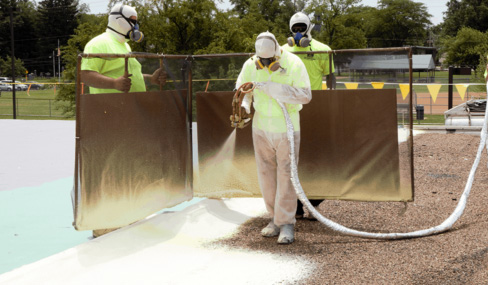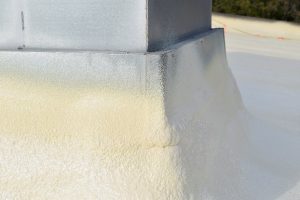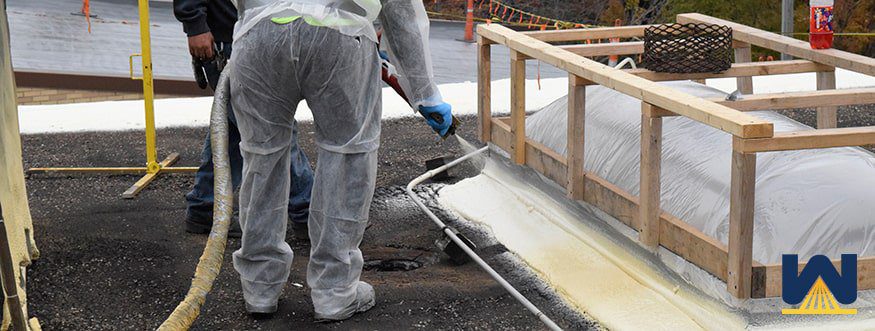If you’re a building owner or property manager, when it comes time to decide on which roofing system is right for your building, there are many variables to consider:
- Cost
- How long the system will take to install
- How long the system will last
- And much more
But one variable to consider is how your new roofing system will be applied around all your roof penetrations.
If you have a roof with multiple HVAC units and pipes running everywhere, installing the wrong roofing system can increase the cost of the project, lengthen the installation process and leave your roof more prone to leaks.
Today, we’ll talk about spray foam roofs and how they are applied around penetrations.
But first, what are roof penetrations?
A roof penetration is anything that comes through the roof. Examples of penetrations are:
- HVAC units/curbs
- Skylights
- Vent pipes
- Drains
Penetrations are a major problem when installing a new roof because they require custom cutting, bending, or some type of reshaping to ensure no leaks will come through.
Spray polyurethane foam requires no changes to the way it’s applied.
Why does spray foam have an advantage when applied around penetrations?
Spray foam has an advantage over every other roofing system when applied around penetrations because spray foam is…sprayed on.

Because spray foam is sprayed, it can be applied at least 80% faster than other roofing applications around penetrations.
In this video, it shows that foam can be applied around a penetration in about 2 minutes (whereas another roofing application would take about 30 minutes):
NOTE: keep an eye out when comparing roofing quotes. Non-spray foam roofing contractors can add up to one hour of labor per penetration in their quotes.
How do other roofing systems handle penetrations?
Other roofing systems, such as single-ply, metal, BUR, modified-bitumen, etc. have boots that will go on the pipes and a wrap that goes around those pipes to make the penetration part of the roof system.
They will do a sheet good right up to the pipe, and then flash around the pipe and back onto the roof.
There will be a seam at every one of those penetrations.
Why is roofing around penetrations so important?
Penetrations and seams are two of the most vulnerable ways water can enter a building.
Seams are the first section of a rubber roof where the adhesion gets loose. Once the seams are loose, it won’t take long before they’re completely apart, and it creates an easy way for water to enter the building.
On some older, gravel build-up roofs, the roof may still be performing well, but all their flashings and penetrations are shot, creating leak opportunities.
How does spray foam get applied around an HVAC unit?
Most roofs will have an HVAC unit that’s set on top of what’s called a “sleeper”, which is a 4×4” or 2×4” piece of wood that holds the HVAC unit off the roof surface.
These create difficult situations to roof under/around.
A single-ply roofing contractor will lift the HVAC units off that ground, roof underneath, and put the HVAC unit back on the 4x4s.
Spray foam roofing contractors will make a wood frame, put a metal cap on top and lift and set the HVAC unit on top.
They do this so they can spray foam over top of the curb, keeping that roof curb part of the monolithic, seamless roofing surface.

What about flashings around penetrations?
Flashings are perimeter edges (usually metal) that are located where a vertical wall meets a horizontal wall (like near an HVAC unit or pipe). These areas are at high risk of allowing water into the building because it’s an area that’s fully exposed to the elements.
If the flashing is damaged or gets bent away from the vertical structure, it will create an opportunity for water to enter the building.
Spray foam roofs take out this risk by spraying over the top of flashings and creating a closed-cell, monolithic relationship with the rest of the roof.
How does spray foam go around scuppers?
Scuppers on a roof are holes that allow water to drain through them and off the roof. Depending on the size of the roof and the amount of water projected to come through, scuppers are usually around the size of a shoebox.
When applying spray foam around a scupper, it gets applied like any other penetration. We spray right around the perimeter so that the scupper becomes a part of the monolithic roofing system.
Here is a quick video showing how spray foam gets applied around a scupper:
Conclusion on penetrations and spray foam roofs
The goal of a spray foam roof is to create a monolithic layer across the entire roofing surface. Doing this creates no seams, which are always a high risk of creating leaking opportunities once the roof is at an older age.
A common penetration, an HVAC unit, is usually handled in a single-ply roofing system by raising the HVAC unit and roofing underneath.
However, a roofing contractor that sprays foam will create a curb for the HVAC unit to rest on, so the contractor can spray the curb (instead of the unit) and maintain the monolithic layer across the entire roofing surface.
At West Roofing Systems, we prepare, install and maintain spray foam roofing systems for businesses anywhere east of the Mississippi. We install spray foam that can go around any penetration, but we still frequently get asked what will happen when the foam actually gets sprayed down and if it will prevent that penetration from leaking.
We hope this article has helped you learn a little bit more about spray foam around penetrations. If you have any questions, feel free to leave them in the comments below and we’ll get back to you with an answer as soon as possible.
Want to learn more about spray polyurethane foam roofs? Here are some popular topics:


